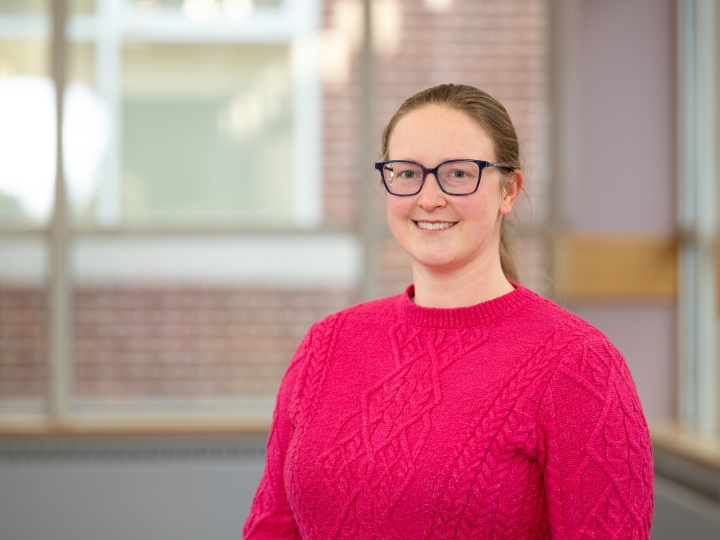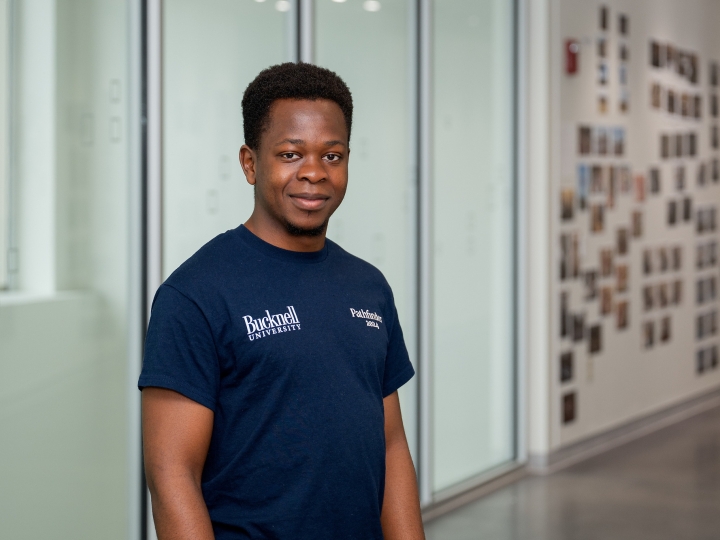Research Illuminates Lives of Immigrants in Pa. Coal Town
February 15, 2016
The first thing Erin Frey '17 saw as she rode into the west end of Mahanoy City was a huge exposed coal mine. The Bucknell University junior and Maryland resident had never been to a mining town before she visited the Schuylkill County, Pa., community in summer 2015.
"It was alien to anything I'd ever seen," said the comparative humanities, creative writing and economics major. "In the borough itself, a lot of the buildings are in the process of collapsing. The aesthetic seemed somber."
Frey and Nick Kupensky, then visiting professor of comparative humanities and an alumnus of the Bucknell Class of 2007, had made the hour-long drive from campus to the borough of 4,000 as part of a faculty-student research project that would unearth the works of a poet-priest, shed light on the obscured Carpatho-Rusyn cultural heritage of the area and reveal historic attitudes toward immigrant laborers.
The Emil Kubek Project originated in 2014 while Kupensky was investigating writers who shared his own Carpatho-Rusyn heritage. (A stateless ethnic group from the Carpathian Mountains of Eastern Europe, the Rusyns speak a Slavic dialect.) One author in particular drew Kupensky's interest: Father Emil Kubek, who had served as rector of St. Mary's Byzantine Catholic Church in Mahanoy City from 1904 to 1940. European scholars have studied the works of Kubek, but he is little known in the U.S., said Kupensky.
Kupensky did not at first realize how close Mahanoy City was to Bucknell's campus, until he remembered the name from a New York-to-Lewisburg bus timetable. "I had to go," he said, "to see where he lived and to try to see if his works were set there."
Kupensky enlisted Frey, who had taken two of his courses, as a collaborator. "Erin had written a paper on Polish film for Humanities 150. She has considerable talents as a writer and researcher in the humanities and an interest in Polish and Slavic culture, so I thought she'd be the perfect person to recruit," he said. Frey is a Presidential Fellow, one of a select group of merit scholarship recipients who pursue long-term research projects and experiences with faculty mentors.
The two received funding for their project from Bucknell's new Coal Region Field Station, which is located in Mount Carmel, Pa. and operated in partnership with the Mother Maria Kaupas Center. The station is a resource for Bucknell faculty, students and staff to pursue novel, interdisciplinary learning experiences with coal region communities. Kupensky and Frey then connected with leaders of the Mahanoy Area Historical Society to become acquainted with the town and the archival resources available to them.
"It was quite a surprise when Nick and Erin showed up in town. We had no idea Fr. Kubek was so well known in other parts of the world," said Paul Coombe, a historian and web master of the historical society.
According to Peg Grigalonis, president of the historical society, the once-prosperous town had attracted thousands of immigrants in the 19th and early 20th centuries, turning it into a "small European city" that was home to writers, artists and composers. "It was a city with many different languages, customs, foods and interests that gradually blended into an enriched place to grow," said Grigalonis. Mahanoy City has since the end of the coal boom seen its population contract and age and the infrastructure decay.
Frey said she wanted to imagine the town as it was in the early 20th century, during Fr. Kubek's service to the community. "What was life like for the Slavic immigrant men working in low-paying, dangerous mining jobs," said Frey, "and for their families trying to establish new lives and communities in a sometimes hostile environment?" She spent the summer mapping the ethnic composition of the city to visualize Slavic neighborhoods and combed through census records to gather data showing that Rusyn families had been concentrated in the west end of Mahanoy City.
She also conducted a discourse analysis to understand how newspapers were portraying the immigrants. Using newspapers.com and ancestry.com, she culled articles from local papers including the Mount Carmel Daily Item, searching for any stories that mentioned Slavs. From those she used software to create a word cloud highlighting the terms most often used to describe Slavs.
"Words like 'murderer,' 'stabbing,' 'strikers' and most of all 'foreigners' came up," said Frey. "The Rusyns were not looked upon favorably by other groups in the region."
Meanwhile, Kupensky and Coombe had made a major discovery: In the archives was a Kubek text that had been translated into English for the local papers. "This first English translation of his prose showed that Kubek wasn't only writing for the Rusyns, he was writing for the entire town," said Kupensky. He continued translating Kubek's works, which he says offer a different perspective from the newspapers' on the Rusyn immigrants. "Kubek portrays them for their hard work, honesty, honor and desire to assimilate alongside nostalgia for the old country," he said.
Kupensky and Frey made several more trips to Mahanoy City. By then, Frey had developed an affinity for the town. "When I would visit, older residents would stop me. Everyone was so friendly," she said. "They wanted to talk about what Mahanoy City used to be like. It was huge and busy and they're upset about the crumbling houses and how they're affecting their own property. They are glad someone is interested in their hometown."
On one of the drives back and forth from campus, Frey and Kupensky began to brainstorm ways to share their discoveries. They came up with the idea for a walking tour that would highlight Fr. Kubek's life and work and the Rusyn neighborhood he served.
On November 22, 2015, almost 100 people gathered for the tour, including Fr. Kubek's great-grandson Martin, who learned about his ancestor's international reputation for the first time. Kupensky read Kubek's poetry at each of the stops, which included St. Mary's church; the mansion of successful Carpatho-Rusyn businessman John Zhinchak Smith; the site of a former grocery store; and Fr. Kubek's grave. Special guest Drew Skitko of the Philadelphia Opera Company performed Carpatho-Rusyn folk songs and an adaptation of Kubek's poem "My Native Land." The tour ended with a reception featuring Carpatho-Rusyn food including pascha bread, pierogies and halupki (stuffed cabbage).
Bucknell's Place Studies Program, a focus of the Bucknell Center for Sustainability & the Environment, provided financial and logistical support for the walking tour. "Place Studies supports projects that work to understand, imagine, sustain and engage people with their place," said Shaunna Barnhart, the program director. "This project imagines Mahanoy City at a historical juncture and celebrates the immigrant experience, coal-mining history, a poet's life and faith in early 20th-century America and the rural-urban experience. It's just the kind of project Place Studies supports at Bucknell."
Grigalonis said the tour has brought a buried history to the surface and revitalized it. "There were some great conversations about who am I really — Slovakian, Greek, Polish?" she said. "Who were these Carpatho-Rusyns? Arguments started over what was the first bar in town. Neighbors swept up their sidewalks. We discovered that the St. Mary's founder and primary benefactor, John Zhinchak Smith, not only was a butcher, banker and steamship agent but a champion of his religious and cultural heritage and arguably the wealthiest Carpatho-Rusyn of his time. And I grew up four doors down from his house!"
Coombe said the project has sparked interest among locals in creating walking tours related to other topics the will connect the past and present of Schuylkill County communities. "The historical society is thankful that Bucknell came in and did such an excellent job," he said. "They brought an expertise and professional approach that most volunteers don't have. Nick and Erin did so much with the little bit of information that we gave them. We dug the first shovelful of dirt in our records and they made a 10-foot hole."
Kupensky is now at Yale completing his doctoral dissertation in Slavic languages and literatures. He continues to curate the Kubek Project website, adding new translations as he completes them.
Frey is continuing her work on the project with guidance from Professor Katie Faull, comparative humanities. In fall 2015 she took Faull's Data Visualization course to better understand how visualizing data in the humanities can reveal patterns and networks of information. She has been inventorying coal region newspapers conducting further discourse analysis and applying her creative writing skills to analyzing Kubek's sentence structures and approach to writing. | See more about the digital humanities at Bucknell.
"It's so easy to engage with many different facets of your interests in one project with a professor here," said Frey. "This project connected all three of my majors. It all tied together. And I found new interests, including the connection I feel to Mahanoy City. It's fun to see all that come together in a real-world approach."
"Our project shows how research in the humanities not only leads us toward different types of knowledge, but it does things," said Kupensky.

